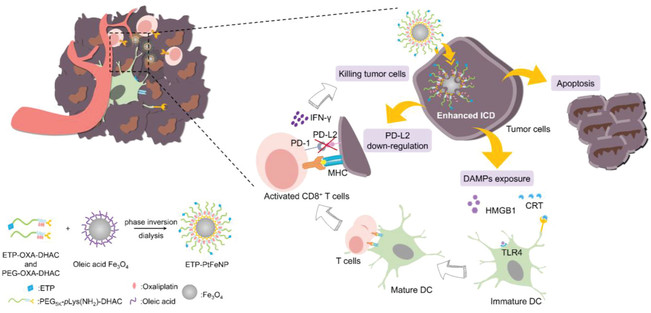
Recently, Professor Chen Jiang’s group from Fudan University School of Pharmacy developed a new type of prodrug-loaded ferric oxide nanoparticles, and relevant anti-tumor immunotherapy as well as microenvironment-responsive tumor MR imaging. The relevant studies were published online in Advanced Science, entitled "Tumor Microenvironment-Triggered Aggregated Magnetic Nanoparticles for Reinforced Image-Guided Immunogenic Chemotherapy".

Representation of preparation and elevated antitumor immune responses with ETP‐PtFeNP treatment.
Although great success has been obtained in the clinic, the current immunotherapy strategies, such as immune checkpoint inhibitors, still face two challenging problems: low response rate and immune-related adverse effects (irAEs). Therefore, developing an effective therapeutic strategy to overcome the challenges in anti-tumor immunotherapy is the top priority.
In addition to cytotoxicity, some traditional chemotherapy drugs (such as oxaliplatin) can induce tumor cells to expose the nonantigenic immune-stimulating molecules (like CRT, HMGB1, HSP70/90, ATP) during anti-tumor treatment, termed as immunogenic cell death (ICD). These stimulatory molecules can promote the maturation of antigen-presenting cells and the recruitment of cytotoxic lymphocytes, eventually upregulating the local anti-tumor immune response. This treatment strategy is expected to become a new type of anti-tumor immunotherapy. Studies on the mechanism of ICD have found that the release of immune-stimulating molecules is closely related to the level and distribution of intracellular oxidative stress (ROS), and effective endoplasmic reticulum (ER) stress is a key trigger for the membrane transport of "eat me" signaling molecule calreticulin. Although oxaliplatin can produce singlet oxygen via NOXs activation, the generated singlet oxygen would be easily dismuted into hydrogen peroxide by SODs, which reduces the level of induced ROS. Recent studies have shown that ferroptosis can induce a large amount of ROS production in a short time through the Fenton’s reaction, and the substrates are hydrogen peroxide. Based on the above, the authors designed a novel microenvironment-triggered aggregative ferric oxide nanoparticle loaded with platinum prodrugs for reinforced image-guided immunogenic chemotherapy. After tumor-targeting accumulation and endocytosis, the platinum (IV) complexes were activated by intracellular reductive elimination to yield and release the Pt (II) congener, oxaliplatin, leading to DNA lesions and ROS generation. Simultaneously, degradation of Fe3O4 was in progress to increase the intracellular concentration of Fe2+/Fe3+, which elicited the generation of highly toxic ROS (?OH or ?OOH) and interfered with the intracytoplasmic redox balance (such as
ER stress), resulting in enhanced ICD-associated immunogenicity and specific antitumor immune responses to kill the tumor cells synergistically. At the same time, ferric oxide nanoparticles accumulation due to the departure of the shielding oxaliplatin enhanced the MRI contrast effect and realized the effective diagnosis of tumor. This study provides a new idea for anti-tumor immunotherapy.
Qinjun Chen, a PhD candidate from School of Pharmacy, Fudan university, is the first author, and Professor Chen Jiang is the corresponding author. The work was supported by National Natural Science Foundation of China for Distinguished Young Scholars, Shanghai Outstanding Academic Leaders Plan and Fudan-SIMM Joint Research Fund.